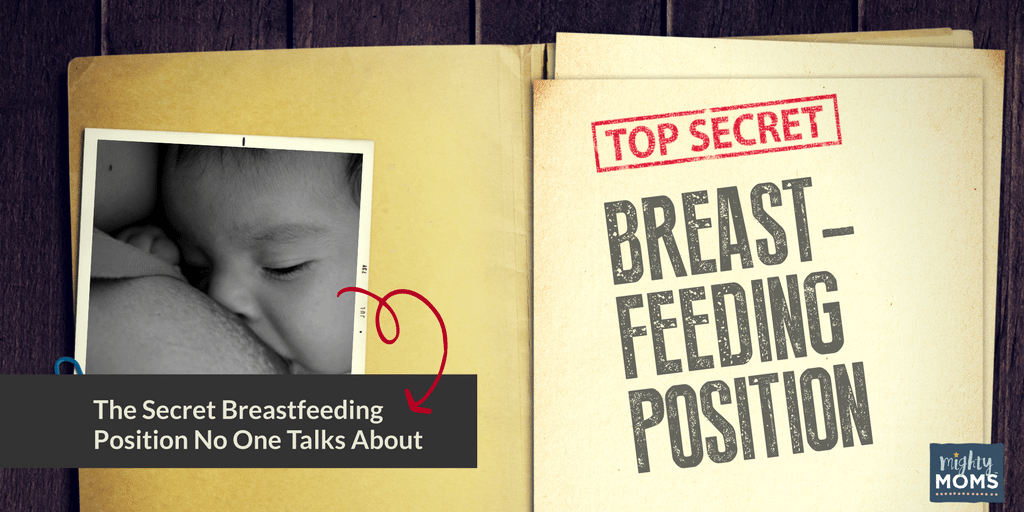
It’s time.
Time to rave about a breastfeeding position that can make a huge difference in your breastfeeding success. And, strangely, it’s the position that no one ever talks about!
You can read all KINDS of articles about the Football Hold, the Side Laying Hold, the Cradle Hold, the Cross Cradle Hold, and the Cats Cradle Hold pretty much anywhere. (Okay, probably not the Cats Cradle Hold…)
But this breastfeeding position?
I can neither CONFIRM NOR DENY the existence of the Diva Breastfeeding Position.
HOWEVER.
If someone were to share the details of this position, IF I tell you, it would have to be posted on some little website in the Great Nothingness of the Internet.
Perhaps on a website we’ll just call….Schmighty Schmoms. (We can’t be too careful…)
Why Didn’t Anyone Tell Me About This?
I have three daughters, all of whom I breastfed (not exclusively, but breastfed is breastfed, right?). Both my eldest (Lauren) and youngest (Isabella) were fairly easy breastfeeders. We would hit our stride around the fourth week, and sail smoothly until weaning around 10 months.
…but that middle child. That precious Elena.
For reasons unknown to me at the time (and I’ll share with you in a moment), nursing her was an uphill battle. Latching was awful. Within three days my nipples were bruised, cracked, and bleeding.
Eventually my lactation consultant gave me some nipple therapy tips that helped me heal quickly enough to keep going.
We made it, but barely.
When I started writing online about babies online in 2007, I began delving deeper into the subject of breastfeeding. I was shocked at what I didn’t know.
Here I was: breastfed three babies, attended nursing classes, had a lactation consultant…and I never heard about the breastfeeding position that could have fixed my problems with Elena so easily.
Well, friend, it’s time to pay it forward.
BTW friend, if you’re struggling and think your breasts could use a break, I highly recommend signing up here for a free high-quality breast pump. Aeroflow will do all the hassle work involved to get your insurance company to cover it at no charge to you. (So awesome.)
The Fatal Flaws in Your Typical Breastfeeding Position
There are three potential flaws in the typical positions that could kill your breastfeeding dreams.
- The baby’s weight is supported by the hand, wrist, and forearm. This leads to aching arms and wrists. (The Side Laying breast feeding position is an exception to this.)
- They rely too much on pillows. Pillows stuffed behind the back, under the arms…even fancy schmancy nursing pillows (of which I owned three) can shift around, leaving mothers huddled over a nursing babe like Quasimodo and wishing for a spinal tap.
- If your infant was born using a forceps or vacuum, he has sore spots on the side of his head. Touching his head while positioning may cause him pain.
A Quick “Don’t Hate Me” Disclaimer
To avoid getting angry emails accusing me of being Anti-Football Position or a Cross-Cradle Hater, let me shout a disclaimer:
Some babies thrive with the traditional breastfeeding positions. By all means, shop your breastfeeding position around to see what works best for your infant!
I’m an equal opportunity positionist.
What Makes Some Babies Harder to Nurse
There are two major reasons some babies are harder to nurse than others.
Personality
You can start seeing the clues of your infant’s personality within just a few hours of birth. (Even if you don’t know you’re seeing them until later.)
Since every child is different, it makes sense that every baby has a particular way of nursing. Those “styles” don’t always jive with Mama. Discover what your newborn’s nursing style is in my post, The Muppets Solve Your Breastfeeding Problems.
Skin Sensitivity
Elena was blessed with a particular Taylor family curse: extremely sensitive skin. Now I, having never been born a Taylor (I only married into the curse), had no inkling of how terrible sensitive skin really was.
“Ants. Constantly crawling all over your body,” is how it was explained to me. Your skin literally feels everything.
What does skin sensitivity have to do with your breastfeeding position? Three little words.
Tonic.
Labyrinthine.
Reflex.
Tonic Labyrinthine Reflex is the reason the usual breastfeeding positions were sabotaging my breastfeeding success with Elena.
Destroying Your Breastfeeding Dreams
The Tonic Labryinthine Reflex (which I’ll now call TLR because it’s a nightmare to spell) is a reflex that appears when he’s still in the womb and sticks around a few months after birth.
Basically, in TLR the body automatically responds to the direction the head is touched. For example, if you touch your newborn’s forehead (or the floor does in tummy time), he will draw his arms and legs inward like a turtle.
On the other hand, if you touch the back of his head, he will push his head backwards towards your hand and arch his back, pushing his arms and legs out.
If this reflex is still showing up after 3 months, speak to your doctor. It could be a sign of some developmental delays.
Where other babies may not be as TLR responsive and nurse just fine with standard positions, the personality-driven sensitive-skinned infant will have to battle it out between two reflexes.
AND IN THIS CORNER…
…the TLR pushes the head back in response to the touch on the nape of her neck as you try to position her on the breast.
AND IN THE OTHER CORNER…
…the rooting reflex causes her to open his mouth and try to latch onto the nipple, but from the wrong angle.
The result is on-and-off latching. (That’s a recipe for tearfully sore nipples.)
Poor baby! What’s an infant to do?
Scream in frustration.
LOUDLY.
How to Use the Diva Breastfeeding Position
The gold medal winner for avoiding the TLR is the Laid-Back Breastfeeding Position. (That term is way to boring for me, though, so I’ve renamed it the Diva Breastfeeding Position. Isn’t that so much better?!)
Here’s how:
- Lean back slightly against the side of a couch or bed, inclining like Greek goddess. “Husband slave! Bring me my grapes!”
- Lay your newborn across your tummy, with his cheek near the upper-side of your nipple.
- Let gravity, not your arms or a mountain of pillows, hold your baby in place. (Obviously, if gravity is winning you need to lean back more.)
- By all means, use your hand to hold your breast. But avoid touching the back of your baby’s head.
Still not seeing it? Watch a demonstration in this excellent video or read through this short checklist from La Leche League.
Spread the Non-Secret Secret!
Now that this breastfeeding position has been officially declassified by moi, it’s time to start spreading the good news! By sharing this information with your friends, you’re giving suffering breastfeeders a new “don’t give up option” to try. (Which is definitely worth a share!)
Just that little hope of a new breastfeeding technique to try could mean the difference between a formula pickup and months of happy nursing.
Related Articles:
- Everything a New Mama Warrior Needs To Know About Baby Care
- 3 Reasons Why American Parents are Loving European Baby Formulas
- Does Your Baby Need a Hypoallergenic Formula?
- What’s the Best Baby Bottle? Here Are Some Olympic Winners You Should Try
- How to Choose the Best Baby Formula for Your Superbaby

We ♥ Citations
http://www.llli.org/faq/positioning.html
http://en.wikipedia.org/wiki/Tonic_labyrinthine_reflex
http://www.nancymohrbacher.com/blog/2010/10/11/some-ins-and-outs-of-laid-back-breastfeeding.html
http://www.cradlehold.com/Site/Problems_from_the_Cross_Cradle,_Football,_and_Log_Holds.html
http://media.clinicallaction.org/fall10/CLGenna.pdf
http://www.fhea.com/Newsletter/fheanews_volume11_issue1.pdf



